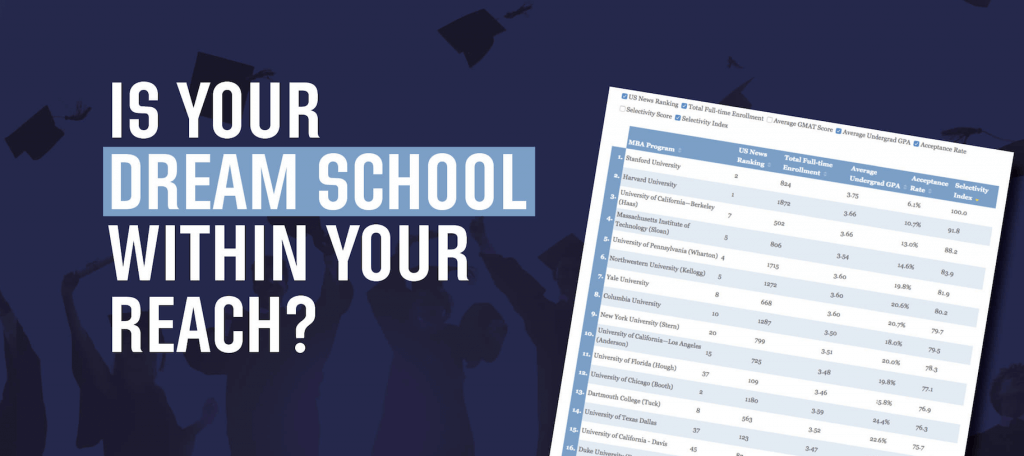Accepted’s Selectivity Index: Are You Asleep When You Apply?

[xyz-ihs snippet=”Selectivity-Index-MBA-Small-Button”] [xyz-ihs snippet=”Selectivity-Index-Med-Small-Button”] [xyz-ihs snippet=”Selectivity-Index-Law-Small-Button”]
I once heard a story about a gentleman who was about to purchase a certain piece of land with the intention of building a school on that property. It was wartime, and the theater of war was rapidly approaching the region in which he and the property were located.
A friend heard about his intended investment, and thought his friend had gone nuts.
“How can you make this purchase now? Are you dreaming?” he asked incredulously.
Replied the real estate investor, “I am dreaming, but I am not asleep.”
Although I heard this story in a context far removed from graduate school admissions, I couldn’t help but think that some of you are “asleep” when you apply – at least the first time.
Dreaming while asleep in admissions:
• Applying exclusively to schools where you are not competitive based on the stats and available information.
• Focusing on the one metric where you are either very strong or very weak. Focusing on the one number that either makes you feel great or makes you feel terrible is another form of “applying asleep.” In either case, you fail to choose schools realistically and consequently “invest” poorly in your overall application effort.
• Ignoring weaknesses when applying so that you fail to address or mitigate them.
Applying “awake” while still allowing for your dreams means that you assess your competitiveness at your target schools by comparing your test scores and grades as well as the non-quantitative factors in your profile to the known stats and stated criteria of the schools you want to attend.
Armed with this information, you:
• Apply to a few “dream” schools, but mostly to programs where you are competitive.
• Assess your weaknesses or strengths in the context of your overall application so that you neither obsess over a weakness nor fail to provide positive reasons for acceptance.
• You work to mitigate weaknesses before and during the actual application process while highlighting strengths and creating a strong case for acceptance beyond the stats in your application.
A few of you may be thinking:
“I know my chances aren’t great at my target schools. But I’m working and making good money. It doesn’t pay for me to apply to any but these schools.”
There are some applicants in this situation. It’s true, but there are very few. If you’re one of them, you are applying rationally. If you aren’t one of them and you could achieve your goals at programs where you are competitive, then well, you may be dozing…
Introducing the Selectivity Index™
Accepted has developed a new tool, the Selectivity Index™, to help you apply realistically and effectively. The Selectivity Index takes the most recent US News rankings data and reflects the schools’ average GPA, test scores, and acceptance rates so that you can assess the relative difficulty of acceptance. You can also order the schools by average test score, GPA or acceptance rate.
[xyz-ihs snippet=”Selectivity-Index-MBA–Button”]
[xyz-ihs snippet=”Selectivity-Index-Med–Button”]
[xyz-ihs snippet=”Selectivity-Index-Law–Button”]
We focused on those key metrics not because they are solely determinative, because they are not, but they do mirror how difficult it is to gain acceptance to a school. They also suggest which schools may be focusing on a particular metric and which may not.
Weaknesses in the Selectivity Index:
1. It doesn’t reflect non-quantitative information, which plays a significant role in holistic admissions and can allow those with non-quantitative strengths to get in when those “more qualified” per the stats are rejected.
2. In doesn’t reflect the schools’ desire for diversity in their classes and community.
3. It doesn’t reflect the importance of showing fit with an individual school’s strengths, mission, and values.
I’m not sure if this is a strength or weakness, but the Selectivity Index does not measure or reflect ROI, educational quality, or career opportunity.
Finally, while the Selectivity Index does reveal the relative level of competition at different programs, it doesn’t excuse you from making sure that the schools where you are competitive also will help you achieve your goals. It does you no good to get into a program that won’t that won’t help you achieve your goals and realize your dreams.
[xyz-ihs snippet=”Selectivity-Index-MBA–Button”]
[xyz-ihs snippet=”Selectivity-Index-Med–Button”]
[xyz-ihs snippet=”Selectivity-Index-Law–Button”]
Related Resources:
• Different Dimensions of Diversity, a podcast episode
• 6 Tips for Talking About Your Weaknesses
• Should You Apply to a Safety School?

